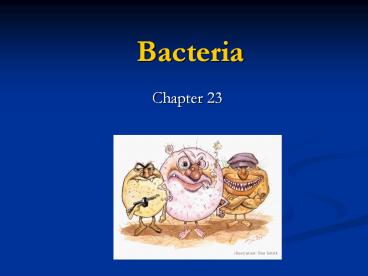Bacteria - PowerPoint PPT Presentation
Title:
Bacteria
Description:
Bacteria Chapter 23 How to treat diseases Antibiotics fungi or bacteria that combat infection by interfering with various cellular functions May lead to ... – PowerPoint PPT presentation
Number of Views:269
Avg rating:3.0/5.0
Title: Bacteria
1
Bacteria
- Chapter 23
2
Bacterial Classification
- Section 23.1
3
REVIEW All Bacteria are Prokaryotes
- Prokaryotes
- Before nucleus
- No nucleus
- No membrane bound organelles
- Eukaryotes
- True nucleus
- Have nucleus
- Have membrane bound organelles
4
Two Domains of Bacteria
- DIFFERENCES BASED UPON RNA MAKEUP
- Domain Bacteria
- Kingdom Eubacteria
- Domain Archaea
- Kingdom Archaebacteria
- More related to eukaryotes
- based upon rRNA gene comparison
5
1. Domain Archaea
- Lack peptidoglycan (protein-carbohydrate
compound) in cell wall - Usually located in extreme conditions like
swamps, salt lakes, and hot springs - Three main types
- A. Methanogens
- B. Extreme halophlies
- C. Thermoacidophiles
Pyrodictium occultum is a marine organism
commonly found in deep-sea hydrothermal vents.
6
A. Methanogens
- Energy source from converting H2 and CO2 into
methane gas. - Live in areas absent of oxygen like swamps,
sewage, and intestinal tract
7
B. Extreme Halophiles
- Salt loving bacteria
- Location anywhere there is a high salt
concentrations like the Great Salt Lake and the
Dead Sea. - Energy source salt need for them to make ATP
8
C. Thermoacidophiles
- hot and acidic enviornments
- They are found in such places as acidic sulfur
springs, undersea vents (smokers) and volcanoes
9
2. Domain Bacteria
- Most abundant domain!
- Examples Cyanobacteria, chlamydia, Lyme
Disease, botulism, TB, E. coli, anthrax,
nitrogen-fixing bacteria - Classified based on
- Gram stain
- Shape
- Biochemical properties
10
Gram Stain
- Gram Positive Bacteria
- Simple cell wall with lots of peptidoglycan
- Stains purple
- Gram Negative Bacteria
- Complex cell wall with little peptidoglycan
- Stains pink
11
(No Transcript)
12
Bacterial Shapes
- Spirilla (spiral-shaped)
- Bacilli (rod-shaped)
- Cocci (sphere-shaped)
- Streptococci long chains
- Staphylococci - clusters
13
(No Transcript)
14
Bacterial Groups
- Proteobacteria
- Gram-Positive Bacteria
- Cyanobacteria
- Spriochetes
- Chlamydia
15
1. Proteobacteria
- Largest and most diverse group
- Many live symbiotically with other organisms
- Nitrogen-fixing bacteria
- Some cause diseases
- Rocky Mountain spotted fever
- Stomach ulcers
- Foodborne illnesses
Video
16
2. Gram-Positive Bacteria
- Some cause diseases
- Strep throat
- Botulism (Botox)
- Anthrax
- TB
- Leprosy
- A few make antibiotics that kill other bacteria
17
3. Cyanobacteria
- Undergo photosynthesis for energy
- Simplest life requirements
- First oxygen-producing organisms on Earth!
18
4. Spirochetes
- Gram-negative
- Spiral-shaped bacteria
- Examples syphilis Lyme disease
19
5. Chlamydia
- Gram-negative
- Coccoid shaped, no peptidoglycan
- Causes a STD that lives inside animals
20
Biology of Prokaryotes
- Section 23.2
21
Bacterial Structures
- Most bacteria are composed of the following
parts - Outer cell wall
- Cell membrane
- Internal foldings thylakoids (photosynthesis)
- Cytoplasm
- Ribosomes
- DNA
- Small molecules and ions
22
Endospores
- Can form in gram bacteria
- Thick-coated, resistant structures
- Form when environmental conditions are poor
- Resistant to high temp, strong chemicals,
radiation, drying, etc.
23
Prokaryotic Movement
- Taxis movement toward or away from stimuli
- Chemotaxis chemical stimuli
- Physical movement aided by flagella or slime
- Patterns of movement wave-like contractions or
corkscrew rotation
Video
24
How do bacteria reproduce?
- Asexually via.
- Binary fission
- Budding
- permits the development of more complex colonial
structures
Binary fission
Budding
25
Genetic Recombination
- Three ways that bacteria can exchange and acquire
new combinations of DNA - 1. Transformation
- 2. Conjugation
- 3. Transduction
26
1. Transformation
- When a bacteria takes on DNA from its external
environment. - Then this new DNA is substituted into the
bacterial DNA
27
2. Conjugation
- When two bacterium bind together and one
bacterium transfers genetic information to the
other. - DNA channeled through the sex pilus
Video
28
3. Transduction
- Steps
- 1. Virus obtains a fragment of bacteria DNA from
its host - 2. Virus multiplies inside host (replicating the
bacterial DNA as well) - 3. Virus breaks out of host cell and invades new
bacteria - 4. New bacterial host will get old hosts DNA
via the virus
29
Know these parts of the bacteria!
- Cell Wall
- Outer Membrane
- Cell Membrane
- Cytoplasm
- Chromosome
- Plasmid
- Capsule Slime Layer
- Endospore
- Pilus
- Flagellum
p. 468
Click above for more info!
30
Bacteria and Humans
- Section 23.3
Video
31
Bacterial Diseases
- Pathology The study of diseases
- Pathogens anything that causes disease
- Bacteria
- Viruses
- Fungi
- Protists
32
Cholera attacking a cell
33
Bacterial Poisons
- Toxins bacterial poisons that cause disease
- Exotoxins made up of proteins
- Secreted by the gram bacteria to surroundings
- Example tetanus
- Endotoxins made up of lipids and carbs.
- Released by dead gram bacteria
- Cause fever, body ache, weakness, and damage
34
How to treat diseases
- Antibiotics fungi or bacteria that combat
infection by interfering with various cellular
functions - May lead to Antibiotic Resistance
- Caused by not taking full dose of antibiotics
35
Emerging Infection Diseases
- Zoonosis a disease that passes from wild animals
to humans - Increase due to global travel of humans
destruction of natural habitat - Example Lyme disease
- Other examples
Video
36
Useful Bacteria to Humans
- Probiotics- useful bacteria in your gut
- Recycle compounds from dead organisms
- Create organic compounds
- Food production (buttermilk, sour cream, yogurt,
cottage cheese, sauerkraut, pickles) - Produce fuels
- Insecticides
- Bioremdiation break down pollutants
Video































